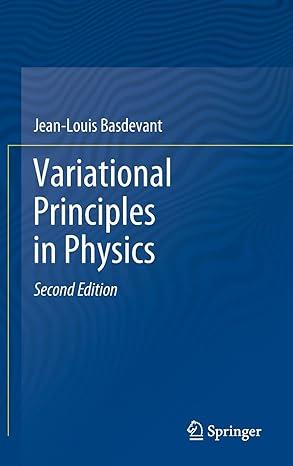The simplicity of the result is intuitive. Quite obviously, as one can see in the definition (7.3),
Question:
The simplicity of the result is intuitive. Quite obviously, as one can see in the definition (7.3), the symmetry of the problem is much larger than the sole rotation in \(\mathcal{R}^{3}\). There is a rotation invariance in \(\mathcal{R}^{4}\). The solutions of maximal symmetry correspond to a uniform motion on a circle of radius \(R\) in a plane whose orientation is arbitrary in \(\mathcal{R}^{4}\). The whole set of solutions is obtained by projecting these particular solutions on planes of \(\mathcal{R}^{3}\), which leads to the elliptic trajectories that we have found.
Consider the case of free motion on the three-dimensional "spherical" space of a sphere \(\mathbf{S}^{3}\) imbedded in \(\mathcal{R}^{4}\)
Obviously, the volume of this space is finite since \(ho^{2}=x^{2}+y^{2}+z^{2} \leq R^{2}\).
In spherical coordinates, the Lagrangian of the problem is
\[
\mathcal{L}=\frac{m}{2}\left(\dot{ho}^{2}\left(\frac{R^{2}}{R^{2}-ho^{2}}ight)+ho^{2} \dot{\theta}^{2}+ho^{2} \sin ^{2} \theta \dot{\phi}^{2}ight) .
\]
Prove the conservation laws of the problem which bring simplifications to the motion:
1. There is rotational invariance. The angular momentum is conserved, and the motion occurs on a plane.
2. We can choose the direction of the angular momentum as polar axis; i.e., \(\theta=\pi / 2\) and \(\dot{\theta}=0\).
3. The Lagrangian of the planar motion therefore reduces to
\[
\mathcal{L}=\frac{m}{2}\left(\dot{ho}^{2}\left(\frac{R^{2}}{R^{2}-ho^{2}}ight)+ho^{2} \dot{\phi}^{2}ight)
\]
4. The conservation of angular momentum, second Kepler's law, results in
\[
\frac{d}{d t}\left(ho^{2} \dot{\phi}ight)=0 \Longrightarrow \dot{\phi}=\frac{A}{ho^{2}}
\]
where \(A\) is a constant, fixed by the initial conditions.
5. The energy, which is a constant of the motion, is therefore
\[
E=\frac{m}{2}\left(\dot{ho}^{2} \frac{R^{2}}{R^{2}-ho^{2}}+\frac{A^{2}}{ho^{2}}ight)
\]
The two constants of the motion \(E\) and \(A\) satisfy the inequality
\[
A^{2} \leq \frac{2 R^{2} E}{m}
\]
which is a direct consequence of the fact that the energy is greater than the rotational energy \(m A^{2} / 2 ho^{2}\). This is a consequence of (7.135); i.e., \(E \geq m A^{2} / 2 ho^{2} \geq\) \(m A^{2} / 2 R^{2}\).
The Eqs. (7.134) and (7.135) are first-order differential equations that determine the motion in terms of the constants of the motion \(E\) and \(A\).
The solution is simple. We define parameters \(\omega\) and \(\gamma\) by
\[
\omega^{2}=\frac{2 E}{m R^{2}} \quad \text { and } \quad \gamma^{2}=\frac{m A^{2}}{2 E R^{2}}
\]
From (7.136), we have the inequality
\[
\gamma^{2} \leq 1
\]
Setting
\[
ho=R \cos (\omega \psi) ; \quad \text { i.e., } \quad \dot{ho}=-\omega \dot{\psi} R \sin (\omega \psi) \text {. }
\]
If we insert this in Eq. (7.135), we obtain
\[
\omega^{2}=\omega^{2} \dot{\psi}^{2}+\frac{\omega^{2} \gamma^{2}}{\cos ^{2}(\omega \psi)}
\]
i.e.,
\[
\omega^{2} \dot{\psi}^{2} \cos ^{2}(\omega \psi)=\omega^{2}\left(\cos ^{2}(\omega \psi)-\gamma^{2}ight)
\]
We now make the change of functions
\[
\sin (\omega \psi(t))=\sqrt{1-\gamma^{2}} u(t) ; \quad \text { therefore } \cos ^{2}(\omega \psi)=1-\left(1-\gamma^{2}ight) u^{2} \text {. }
\]
Show that the choice
\[
u(t)=\sin (\omega \zeta(t))
\]
leads with no difficulty to:
\[
\dot{\zeta}^{2}=1, \quad \text { namely } u=\sin \left(\omega\left(t-t_{0}ight)ight)
\]
and to the result, i.e. The expressions of \(ho(t), \tan \left(\phi(t)-\phi_{0}ight)\) as well as the frequency \(\omega\).
\[
ho(t)=R \sqrt{\cos ^{2} \omega\left(t-t_{0}ight)+\gamma^{2} \sin ^{2} \omega\left(t-t_{0}ight)}
\]
which is periodic and of frequency \(\omega\). The calculation of the time evolution of the azimuthal angle \(\phi(t)\) is obtained by this expression and Eq. (7.134),
\[
\dot{\phi}=\frac{A}{R^{2}\left(\cos ^{2} \omega\left(t-t_{0}ight)+\gamma^{2} \sin ^{2} \omega\left(t-t_{0}ight)ight)} ;
\]
i.e.,
\[
\tan \left(\phi(t)-\phi_{0}ight)=\gamma \tan \omega\left(t-t_{0}ight)
\]
which is also periodic and of frequency \(\omega\).
We conclude the following.
Step by Step Answer:






